
Homes for Heroes 100 Awarded Lottery Support
In January 2019 it was announced that a group of Bristol projects marking 100 years of council estates had been awarded funding from the National Lottery Heritage Fund (NLHF).
Homes For Heroes 100 is a programme of activity working with communities in Sea Mills, Hillfields and Knowle West to explore the history of these areas and the people that have lived and worked there over the last century. There will be a new book written by people who have grown up on council housing estates; artists engaging with communities led by the Knowle West Media Centre and the Architecture Centre; the story of council housing in Bristol told in comic-book style; walking tours around the estates; a day event as part of Festival of the Future City; the planting of an oak tree at a new council housing site, commemorating 100 years since the building of the new housing at Sea Mills and the planting of the Addison Oak; and much more.
Homes For Heroes 100 is being coordinated by the Bristol Cultural Development Partnership, who have been responsible for a number of citywide partnership programmes, including Bristol2014, which marked the centenary of the start of the First World War, and the arts projects which ran alongside Bristol’s year as European Green Capital. The programme will not only look at homes – their layout, how and why they were built – but also other buildings on the estates, including schools, libraries and pubs, and the differences that they made to the communities who lived there. It will also support two community projects which have already received funding from the National Lottery – Sea Mills 100, who are using a refurbished telephone box to share stories from the past; and a new project in Hillfields being run by Local Learning.
The 1919 Housing and Town Planning Act, known as The Addison Act after the then Minister of Health and Housing Christopher Addison, introduced the start of the first significant era of council house building in the UK. It came in the wake of a speech delivered by Prime Minister Lloyd George regarding British troops returning from The Great War in which he called for ‘a country fit for heroes to live in’.
Andrew Kelly, Director, Bristol Cultural Development Partnership (now Bristol Ideas), said:
‘The 1919 Addison Act was not just about building homes; it was about creating communities and changing the social fabric of the country. Originally promoted as homes for the returning heroes of the war and as fresh starts for those displaced by slum clearance, in recent decades council housing – and the social housing that has partly come to replace it – has attracted an unwarranted stigma. Council house residents have been marginalised for generations and the culturally important heritage that lies within their estates is little-known. Through community-based research and hands-on activity leading to high-profile showcases in the estates involved, the city-centre and online, the Homes for Heroes programme will celebrate the council estate past, present and future.’
Bristol’s first post-war council house tenants moved into Beechen Drive, Hillfields in 1919 where there is now a commemorative plaque. In September 1920 over 87 per cent of the 676 applicants for houses on the Hillfields estate were from ex-service personnel.
Pete Insole and Ruth Myers, Local Learning, said:
‘We are very excited about working with the Hillfields community to celebrate this important event in both the city’s and nation’s housing history. We are looking forward to finding out more about the impact of Addison’s Housing Act and having fun re-enacting the architectural competition with local residents in the style of a Reality TV Gameshow.’
Other estates across the city were soon completed. The first sod at Sea Mills was cut by Addison himself in a ceremony that took place on 4 June 1919: an oak tree was planted in Sea Mills Square to mark the occasion and remains today. In 1937 John Betjeman referred to Sea Mills as ‘that magic estate’ and in 1981 it became one of the first council estates in the country to be designated a conservation area.
Mary Milton, Sea Mills 100, said today:
‘We are delighted that the National Lottery is supporting our project which has already begun to bring the community together in Sea Mills and give us a new appreciation for where we live.’
Together, the whole programme of activity has been awarded over £80,000 raised by National Lottery players, making it the largest celebration of the centenary of social housing happening anywhere in the UK.
Nerys Watts, Head of Heritage Lottery Fund South West, said:
‘This year marks not only the centenary of the Addison Act but also the centenary of the communities it helped to create. Thanks to National Lottery players, those communities in Bristol will take the lead in putting their own history on record for the first time, challenging perceptions and coming together to celebrate their future.’
As well as looking to the past, the Homes For Heroes 100 will also try to help to change the image of council housing and returning to the utopian ideas and hopes that the first council houses represented in the lives of their tenants. The programme has strong backing from Bristol City Council, who will be contributing a further £80,000, as well as Arts Council England, Bristol Cultural Development Partnership and Heritage Schools. Planning issues and debates around the nationwide shortage of housing will be raised and the new areas of social housing being created by Bristol City Council will be celebrated. The most significant of these occasions will be the planting of a ceremonial oak tree at one of the new estates on the centenary of the planting of the oak tree at Sea Mills.
Cllr Paul Smith, Bristol City Council, said:
‘Not enough new homes are built each year in Bristol to meet the demand and this results in high rents and escalating house prices. We want to show that providing affordable homes can be done. Taking the time to celebrate and be inspired by the first waves of Homes for Heroes is a great way of helping us plan for the future.’
Follow the project on Twitter using the hashtag #HomesForHeroes100

